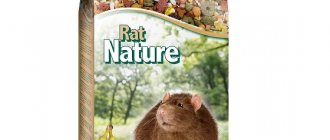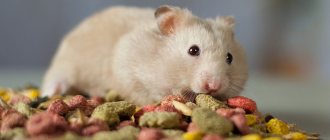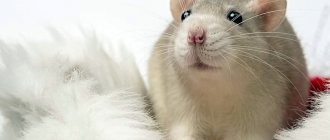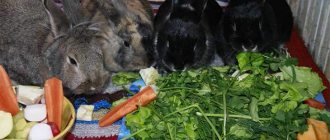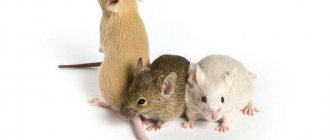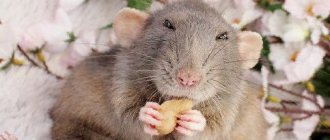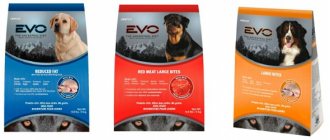Dry food for rats is the basis of the diet of these ornamental animals. A bowl with it must be present in the cage around the clock, especially in the case of young animals. A balanced diet is the basis for a long, healthy life for your pet, but choosing the right option from the huge variety of products on the market can be difficult.
New rat owners often wonder which mixture is best. Why do some of them cost several times more than others? Does it make sense to overpay? Can the food be used for hamsters, ferrets or degus? Unfortunately, pet store salespeople rarely have sufficient training to provide expert advice. In order to help young rat breeders, I have compiled the top 8 foods for rats, which includes the best products in different price categories.
comparison table
I have collected the main characteristics of all the foods included in the rating into a single comparative table. With its help, the reader will be able to quickly and more conveniently determine which product he should purchase.
| Model | Class | Type | Compound | Special properties |
| Vitakraft Premium Menu Vital | Premium | Combined | cereals 72.4%, fruits 10%, nuts 8%, plant products, minerals, vegetables, milk and dairy products, oils and fats, inulin, seeds, yucca extract | Reduces the odor of rat products. |
| Little One Rats | Economy | Combined | wheat, rolled barley, oatmeal, puffed wheat, multigrain granules, corn flakes, oats, red corn (5.85%), barley, rolled peas, rolled sweet lupine, puffed corn, extruded corn, buckwheat, rolled beans, carob (carob), sunflower seeds, dried banana (2.5%), fructooligosaccharides (0.6%), yucca extract (0.01%). Analysis: proteins - 12.2%, fats - 4.1%, fiber - 4.3%, ash - 7%, calcium - 0.9%, phosphorus - 0.6%. | No |
| Beaphar Care+ Rat | Super premium | granular | cereals, vegetables, seeds, minerals, plant products (yucca schidigera 0.10%, echinacea 0.03%, green tea extract 0.01% FOS 0.01%), meat and animal products (poultry 1.5 %), yeast (MOS 0.19%), algae (spirulina 0.01%) | Helps grind teeth, supports immunity |
| Fiory Superpremium Ratty | Premium | Combined | Flour and alfalfa granules, wheat, rye, whole oats, barley, buckwheat, corn flakes, beets, corn kernels, vegetable granules with honey and yucca extract, cereal rings, peas, white sunflowers, carrots, peanuts | Support immunity, reduce odor |
| Vitapol full radio | Economy | Combined | wheat, barley, buckwheat porridge, cereal mud and cereal products, post-extraction sunflower mud, alfalfa flour, pressed peas, pressed beans, striped sunflower, black sunflower, pumpkin seeds, pressed corn, carrots, beets, oats, potatoes, corn flour, oatmeal flakes, meat pellets, raisins, parsley, dandelion, mint, grass meal, feed yeast, flaxseed, wheat flour, rice flour, beet pulp flavored with molasses, carrot flour, carotene | No |
| Waka High Quality | Economy | Combined | grass granules (cereals, clover, vetch, alfalfa), granulated feed (wheat bran, flaxseed, bone meal, iodized salt, brewer's and bread yeast, vitamin complex), wheat, oats, barley, pumpkin seeds, legume seeds, seeds sunflower, cereal flakes, dried fruits and vegetables, probiotic. | Stimulates immunity |
| Happy Jungle 5 in 1 Daily Menu | Economy | Combined | wheat, grain granules, barley, oats, red millet, white sorghum, black sunflower seeds, buckwheat, crushed corn, pea flakes, flax, puffed wheat, extruded granules, puffed barley, dried pineapple, roasted peanuts, banana chips, carob, | Maintaining immunity |
| Versele-Laga Nature Rat | Premium | Combined | cereals, plant derivatives, plant protein extracts, vegetables, nuts, seeds, fruits, oils and fats, minerals, yeast, fructo-oligosaccharides, calendula, seaweed, calendula extract, yucca extract, herbs, grape seed extract. Ingredients: crude proteins 17.5%, crude fats 9%, crude fiber 7%, crude ash 5%, calcium 0.60%, phosphorus 0.45%, lysine 0.81%, vitamin A 12,000 IU/kg, vitamin D3 1,500 IU/kg, vitamin E 30 mg/kg. | Maintaining immunity, combating unpleasant odors. |
Features of feeding decorative rats
Many people completely mistakenly believe that rats can be fed pet food. Although they are omnivores, their digestive system and metabolism are specific.
Diet features
This should be taken into account when creating a balanced diet. Including:
- carbohydrates - 65%;
- Proteins - 25%;
- fats - 10%.
Therefore, human food with huge amounts of sugar, salt, and fats is harmful to the health of a pet’s tail. And the high levels of chemical additives in it are lethal.
The diet of a decorative rat consists of three components:
- Basic food. To maintain vitality, 30-40 g per day of special nutrition enriched with vitamins is enough. The daily rate depends on the age of the animal, its size and living conditions.
- Feeding. These are three main groups of products, the consumption of which normalizes the life processes of the animal and helps strengthen the immune system. It is necessary to know exactly which groups of additional food products and how to introduce them to animals. The first group is vegetables and fruits, which are given every second day in the amount of 15-20 g per person. An overdose of juicy foods can cause gastrointestinal diseases. The second includes products containing animal proteins with essential amino acids. It is recommended to give them 20 grams no more than twice a week. Rats need more animal protein to support their growing bodies. The third group includes dairy products, a source of calcium that can be spoiled once a week by giving them a tablespoon.
- Treats. You can treat your pet to some tasty treats from time to time. This could be: toast, baby puree, cookies, dark chocolate, and some other treats. The main thing to pay attention to when giving treats to your pet is to not overdo it with the quantity and frequency of giving it. Otherwise, serious problems may arise associated with the animal's excess weight, hormonal disorders, digestive tract disorders and refusal to eat regularly.
A decorative rat must be fed solid food to grind its teeth, which it grows throughout its life: carrots, bread crumbs, cookies, branches of fruit trees.
When feeding berries and fruits with a pit, it is recommended to remove it in advance to avoid poisoning with cyanic acid, which is poisonous to rodents.
When including meat and fish in your pet's diet, it is important that they are lean and cooked, even with broth.
The following foods are strictly prohibited:
- Candies;
- sausage;
- fatty and spicy foods;
- citrus;
- raw fish, meat;
- raw legumes;
- raw potatoes;
- pumpkins;
- Cabbage;
- Alcohol;
- spinach.
Feeding recommendations
To keep your pet healthy and happy, there are some important nutritional rules you need to follow.
- Don't switch from one food to another suddenly. Change gradually, in small quantities over several days, adding the foods you plan to switch to.
- Keep rat food off the table. The composition of human food and the ratio of nutrients can be harmful to the health of the animal.
- Diets containing animal protein, such as eggs, cottage cheese and lean meats, should always be included in your pet's diet.
- Grains (oats, barley, wheat), which are present in the heap every day, should not be crushed, so as not to remove the vitamins and microelements necessary for the rat.
- As a vitamin supplement, be sure to give green grass in the summer, hay, green oat sprouts in the winter, and nettles in the spring. During the year - chopped raw and boiled root vegetables.
- Pregnant females and growing young animals should be given mineral supplements (chalk, calcium gluconate, phytin) in their diet.
- The presence of clean water in a drunkard is a must.
- It is recommended to prepare porridge without adding milk for elderly, sick, and weakened people.
- Rats with an appetite for sweets can be pampered from time to time with a portion of raisins, berries, and dates.
- Rats under six months of age should not have limited access to food and should always have it in a bowl.
When preparing a diet for decorative rats, preference should be given to ready-made, specialized dry food, balanced in nutrients, vitamins, and microelements.
Best lists
After studying rat food on the market, analyzing the composition and customer reviews, I identified the best offers in the “economy”, “premium” and “super-premium” categories.
Vitapol Karma - the best economy food
Despite the fairly low price, this food has a good and balanced composition, which allows us to call it a transitional option from economy to premium. Particularly noteworthy is that the manufacturer announced the presence of natural meat in the composition - this is uncharacteristic even for many premium mixtures. Vitapol Karma is a good option for those who want to provide their rat with a balanced diet without spending a lot of money.
Vitakraft Premium Menu Vital – the best premium food
Mixtures from the German company Vitakraft are widely used, including by professional rat breeders. The food is distinguished by an excellent combination of price and quality, a rich composition containing all the vitamins and microelements necessary for the health of the rat. The product is additionally enriched with milk proteins, omega acids, which improve the condition of the coat, and inulin, which stimulates digestion. The food is suitable for both adult rats and young animals.
Beaphar Care+ Rat – the best super-premium food
Beaphar offers customers some of the best food on the market. Care+ Rat granular mixture has a perfectly balanced composition, which includes, among other things, natural meat and animal products. Thanks to this, the rats will receive their portion of protein and proteins even without additional feeding. The granules do not contain sugar or other sweeteners or flavor enhancers. The product is very nutritious, so its consumption is lower than most other mixtures. According to the manufacturer, a 250 gram pack is enough to feed one rat for 22 days.
Grain and granular feed: which is better?
There are two types of ready-made food for domestic rodents: grain and granular. How do they differ and which one is better suited as food for tailed pets?
Grain food contains whole grains of cereals and dried slices of vegetables and fruits. Ready-made food in granules is made from the same grain mixture and vegetables, which, after grinding, is pressed into crispy, aromatic granules. Therefore, the composition of both types of feed is almost the same and there are no significant differences between them, except for the release form.
Hard food
Many owners prefer pelleted food for the simple reason that some rats choose only their favorite grains and seeds and flatly refuse vegetable pieces. And the cunning animals eat the granules without leaving a trace, thus getting all the necessary vitamins and microelements from their food.
Pelleted feed
Important: to decide which type of food is best for your little pet, you should offer your little pet a treat in the form of grains, and after a while pour granulated food into his plate. Let the rodent choose what he likes best, tasty juicy grains or aromatic granules.
Types of food for rats
Rat food can be divided into 3 categories:
- Super premium;
- Premium;
- Economy
Super-premium food is a balanced composition that contains all the microelements and vitamins necessary for rats. They are developed under the supervision of professional veterinarians and fully meet the physiological needs of the rat body. The basis of such feed is high-quality wheat grain. In addition, the super-premium class is distinguished by the presence of animal proteins. Most often, manufacturers use lean poultry meat.
Premium class – good value for money. The percentage of wheat grain here is lower - to reduce the cost of the product, it is diluted with oats, barley and other cheaper cereals. Animal protein is rare in such feeds; it is usually replaced with a plant analogue. It should be borne in mind that some premium products may contain too much fat, so it is important to carefully study the composition and, if necessary, dilute the mixture with grain.
The main advantage of economy class is its low price. At the same time, these feeds are often not sufficiently balanced and do not contain all the nutrients the animal needs. Because of this, experienced breeders typically use economy products to dilute more expensive or excessively fatty mixtures.
Combined or granular
Most feeds are combined - they contain a variety of grains and granules. In the case of granulated food, all components are crushed into a total mass, from which granules are formed.
There is no definite conclusion about which type of food is better, however, granular mixtures are better eatable, since in the case of them the rat will not be able to pick and choose from the bowl only those pieces that it likes.
Healthy rat diet
Every owner wants their pet to eat a balanced diet and receive all the necessary vitamins. To do this, just follow simple rules:
- The basis of the diet is food. You need to give it every day, there are no restrictions.
- Complementary foods include fruits, animal protein, vegetables, fermented milk products and various treats. Fruits or vegetables can be given every day or every other day. Approximate weight: 30 grams per adult rat. Animal protein should be given 20 grams 1-2 times a week. There is no need to do this more often. Animal protein includes foods such as eggs, fish and meat. The food must be boiled first.
Feed
The basis of a rodent's diet is food. You can buy it at any pet store or order it from an online store. If you wish, you can make this food yourself from different types of grain, but this takes more time and is not always convenient. Such industrial food will cost much less, but you will need to select and combine different ingredients, which are not always easy to find. When purchasing, be sure to find out that the grains have not been treated with chemicals. This problem is often observed when buying on the market.
One recipe for making homemade food consists of ingredients such as wheat, oats, rye, buckwheat, rice, millet, pumpkin or sunflower seeds, nuts, and corn flakes.
Experienced rat breeders mix food and grain, so pets like this mixture better. From time to time you need to introduce such variety. Although there are cases when you may develop an allergy or intolerance to a certain ingredient.
A rodent should always have food. Especially in babies under 6 months. They should always be within close proximity to food. Dosed nutrition is only possible if you have problems with obesity. Then several times a day a certain weight of food is poured into a bowl.
Vegetable complementary foods
Vegetables and greens contain many useful substances that your pet needs for healthy growth and development. These products are not only healthy, but also not high in calories, so they will not lead to problems such as obesity.
Berries should be avoided. They should be given as rarely as possible and in small quantities.
Fruits are suitable as complementary foods, but their quantity should be less than vegetables.
Vegetable feeding is only a supplement and cannot serve as the main type of diet for a rat. If the amount of vegetables and fruits is significantly higher than normal, this can lead to problems with the stomach and intestinal tract, which will affect the deterioration of the rodent’s health.
The norm is different for each animal and depends on the weight and age of the rat. It is necessary to monitor the state of health and the body’s reaction to a certain type of complementary food. If you have diarrhea, you need to temporarily reduce or completely abandon the herbal supplement.
Protein complementary foods
Do not forget that rats are not vegetarians, so their diet must contain protein supplements. They need meat, fish and eggs to develop and maintain immunity. Animal protein can also be seafood, baby food or super premium cat food.
For baby rats, the dose of protein should be higher than for an adult. This is especially true in the first months after birth. It must be given several times a week for the growth and development of the baby rat.
Fermented milk feeding
Why give your rat dairy products? They contain a large supply of calcium, which is necessary for bones and teeth. Also, kefir, cottage cheese and yogurt contain the necessary bacteria for the intestines. Rats are very fond of fermented milk products, so they always eat them with pleasure.
The exception is if the rodent has lactose intolerance, then such complementary foods should be abandoned. This feature is quite common in rats. It can be identified by poor health and severe diarrhea after fermented milk products. Before giving a new product, you need to check your body's tolerance. To do this, for the first time you need to choose a small dose and look at the pet’s reaction. But even in this case, there is a way out - you can buy a product that is pre-delactated. Finding them is quite easy.
When choosing, you should give preference to products with a fat content of 1-5 percent, but not low-fat. The absence of additives is also mandatory.
There is controversy among rat breeders regarding fermented milk products. Some believe that there is no need to add them to the diet, while others categorically disagree with their use by pets.
Each person chooses whether to give these products to their pet. Whether this affects life expectancy or health has not been proven by scientists.
Treats
Rat owners love to pamper their pets with treats. There is nothing wrong with this if the owner knows which foods are strictly contraindicated for rodents.
You can add nuts, regular cookies or a couple of pasta to your diet. This should be done extremely rarely, as an encouragement for your friend.
Other
Some rat owners like to add baby food or whole vegetable meals to their diet. There is debate about the need for such nutrition and their harm has not been scientifically proven. You just need to know when to stop and not add too many of these products to your diet. You should not give your rats mayonnaise, ketchup, mustard and other sauces.
Should I add porridge to my diet? There will be no harm from such food, but there is not much benefit for the rat either. You should not boil the grains; you can only steam them with boiling water. It is best to opt for buckwheat, millet or rice. This type of food may be prescribed as part of a diet. There is no need to add spices or sugar.
The issue of nutrition is very important, and before purchasing a pet, you should familiarize yourself in detail with the basic principles of feeding.
If you do not follow the basic rules of nutrition for rodents, then a problem such as excessive regrowth of the front teeth may arise. This causes great discomfort. The pet will not be able to eat on its own. At the first signs, you should contact a veterinarian, who will make a diagnosis and prescribe treatment.
If the diet is incorrect, then another serious problem may appear - obesity, which will lead to a significant deterioration in health. You don't need to feed your rat more than twice a day. Normal weight for an adult is from 250 to 800 grams. The male always weighs more than the female.
A prerequisite for nutrition is the presence of water. It should be clean and the drinking bowl should be changed every day. Moreover, you should choose a heavy one so that the rodent cannot accidentally turn it over.
How to choose good food for rats
Before you buy food, be sure to study its composition. It should contain 25% protein, about 45% carbohydrates and no more than 8 percent fat. Unlike most mammals, rats do not have a gallbladder, so eating too fatty foods can seriously harm them, or even kill them. If possible, consult a veterinarian, especially if an old rat or a young rat requires food.
The quality of the feed can also be assessed visually. If it is dusty or has an unpleasant odor, this is an alarming signal. It should be free of debris, mold, bugs, and foreign inclusions. In a good product, the grain is large, without stains or damage. It’s good if the bag is equipped with a zip fastener - this will help keep the food fresh longer and protect it from moisture and pests.
Remember that a rat is a living creature, and that each animal has its own character and preferences. Some of them do not eat grass pellets, or refuse the food simply because they are not used to it. Be sure to check with the breeder or seller at the pet store what mixture the animal was fed, and gradually transfer it to a new diet.
Keeping pet rats
It was only in the late 19th and early 20th centuries that rats began to be domesticated; before that, they were considered only crop pests and caused frequent nuisance.
The lifespan of rats is 2-3 years if all maintenance rules are followed. If a decorative rat lacks nutrients, then it can live much shorter.
After buying a pet, you should think about its home. The cage should be spacious, and inside there should be an enclosed space on several floors. This way the rat can always find something to do in the cage. Rodents love to play. All accessories can be purchased at a pet store. A place to sleep can be equipped with a small cardboard box that will serve as a mink.
The ideal temperature for a pet is +18-+22 degrees. Then the rat will be active and cheerful. Drafts and direct sunlight should be avoided.
You can let a rat out of your house, but you shouldn’t do it from the first moments of acquaintance. The pet may get scared and crawl into the farthest and darkest corner.
Basic nutrition rules
Many people think that if rats are omnivores, then they can just be given everything, but this is not true. Most foods that humans eat are slow poison to rats because they taste too spicy, salty or fatty. Eating such food can result in health problems or even death. Moreover, such a diet is not balanced and sufficient for rodents. This does not mean that you cannot give your rat a small slice of cheese from your table, but you should not do it too often. There should not have been a constant diet, but only an exception from them.
Economy class food: is it worth overpaying?
These are inexpensive foods with poor composition. It is based on grass sticks and various grains (usually rice, oats and barley are the most budget-friendly). It is not recommended by veterinarians because it does not contain essential vitamins and minerals that keep rats healthy.
This is the food:
- Baka, Baka Lux and Baka High Quality. This brand is known for its formulas, which are developed by the world's leading veterinary experts. Balanced and natural composition, affordable price and large packaging. But rejoice early: many owners of decorative rats find that the food is for lovers - many pets refuse to take it;
- Gala dinner;
- Animals and rats from a Russian manufacturer - the composition contains second-grade cereals, seeds of various herbs and herbal granules. These foods contain neither fat sources nor protein-rich ingredients.
- Combined food for rats;
- Favorites;
- Karma.
Super-premium food - for those who do not skimp on the most important things
Such food already contains everything you need for good nutrition. If you choose it, your rat will not need additional food. The food composition is rich: whole grain wheat, flaxseed, sunflower, dried vegetables and meat, as well as various useful additives that support the animal’s immunity.
This is the food:
- Care + rat food. Contains wheat grain, corn, pieces of meat and vegetables, vegetable protein, as well as yeast, algae and various minerals.
- Xstra Vital: Select whole grain wheat, turkey, soybean oil, aloe vera and echinacea. The latter are responsible for your pet's excellent immunity. They also contain essential minerals and vitamins (including phosphorus, copper, calcium, vitamin A and Dental, which strengthen teeth). By the way, this food is recommended for owners whose rats are sick: echinacea extract can quickly return the animal to its feet. And in reviews, owners note the ease of use thanks to a special adhesive tape for opening and closing the packaging, which prevents weathering and loss of organoleptic properties.
Top 8 most popular rat foods
In veterinary pharmacies and pet stores, bags of food for rodents are presented in a wide range, and sometimes it is difficult for owners to navigate and choose the right food for their pet.
You can consult with your veterinarian or simply review the list of the most popular foods that are recommended by tail pet owners to decide which one to choose.
Rating of the best rat food, according to the opinions of the owners.
| Flow | pros | Minuses | costs rub. |
| Xstra Vital | Complete, natural composition | High price | 1100 |
| JR Farm Rat Classic | Variety of ingredients, high quality composition | Availability of dyes | 500 |
| Funny bonus | Nutrient pellets readily eaten by rats. | Needs to be supplemented with vitamins | 450 |
| Emotions Beauty | natural composition, content of vitamins and minerals | Lots of grass pellets that rats don't like. | 400 |
| Little One | Low cost, high quality ingredients | No animal protein | 250 |
| Care + rat food | Balanced composition, presence of vitamins | High price, you have to order on special sites | 850 |
| Rat-complete | It consists of easily digestible granules that are consumed without any leftovers. | Sales only from specialized dealers | 500 |
| Pied Piper | Can be purchased at any pet store, low cost | Low grain quality, poor composition | 80 |
Each animal has its own tastes, and there is no guarantee that a rat will like food that most of its companions will happily eat. Therefore, the owner must take into account the taste preferences of his pet and choose food that will not only be healthy for him, but also satisfy the tastes of a picky and capricious pet.
Homemade food recipes
Some rat breeders prefer to prepare mixtures at home, since they can be sure that the food will not contain chemical additives. Sometimes this is caused by necessity, since store-bought formulations cause allergies in the animal. The basis of the feed is grain crops. By the way, many of them are most often available at home, so sometimes preparing mixtures with your own hands allows you to save money. It is advisable to add as many useful components as possible to the composition.
For example, we recommend using the following recipe:
- whole wheat grains;
- dried fruits of several varieties;
- pearl barley;
- Wheat groats;
- small rice;
- buckwheat;
- pumpkin seeds;
- cornflakes.
All ingredients are taken in equal quantities and mixed. This mixture can be prepared immediately for a month, but it is better to start with a small amount, let your pet try it, and then adjust it, paying attention to what he liked best and what he didn’t. You can also add Purina Pro Plan cat food before serving.
For the following recipe, prepare the following ingredients in equal quantities:
- wheat;
- sunflower seeds (raw);
- pearl barley;
- corn flakes;
- dried banana chips;
- unroasted peanuts;
- barley.
